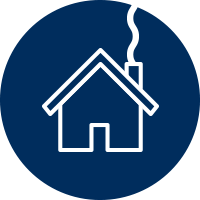
Lightning Protection
Lightning Protection Basics
Lightning is a random and unpredictable phenomenon. Its' physical characteristics include current levels exceeding 250 kA, temperatures exceeding 29 726 °C. Worldwide 2000 ongoing thunderstorms cause about 100 lightning strikes to earth every second.
When two air masses of different temperature and hydrometry come together, the circumstances are favourable for the formation of a storm. A strong ascending airflow drives humidity, ice fragments, hail and water droplets towards the upper part of the cloud.
In the cloud, the separation of the electrical charges is promoted by:
-
The strength of ascending winds with a speed over 25 m/s
-
The simultaneous presence of heavy and light particles of ice in the cloud
When the storm cloud reaches maturity, the electrical charges are spread in different areas of the cloud. The difference in the electrical potential created causes significant electrical discharges; the storm bursts. We can compare the cloud and the ground with an enormous charged condenser. Usually, the negative charge is in the lower part of the cloud and the positive charges are building on the ground when the cloud is approaching.
During a cloud-ground lightning, the negative charges in the lower part of the cloud move towards the positive charges on the ground following a sinuous path. These charges create a channel called a stepped laeder.
The electrical field on the ground increases quickly as the leader approaches the ground. Streamers are created on the top of the objects on the ground.
When the leader reaches the last hundred meters, the ambient electrical field exceeds a critical level and one or more upward leaders develop. Often, competing upward leaders move towards the downward leader. When one of the upward leaders enters in contact
with the downward leader, a capture discharge is created and a short-circuit is created between the cloud and the ground.
When the link is established between the leader and the up-leader, a main discharge occurs: for a short time, an intensive current flows between the ground and the cloud. It is the return stroke, often followed by several subsequent strikes. The first lightning strike is usually followed by other discharges in the same channel. This gives the lightning its wavering appearance. The lightning process goes on until the discharge of the cloud. Large storms can trigger more than 100 lightning strikes per minute.
Approximately 90% of all lightning flashes are cloud-to-cloud with the other 10% being cloud-to-ground flashes. 90% of the lightnings are of negative type. Ground-to-cloud flashes are extremely rare and generally only occur from high mountain tops or tall man-made structures
Lightning effects can be direct and/or indirect. Direct effects are from resistive (ohmic) heating, arcing and burning. Indirect effects are more probable. They include capacitive, inductive and magnetic behavior. Lightning "prevention" or "protection" (in an absolute sense) is impossible. A diminution of its consequences, together with incremental safety improvements, can be obtained by the use of a holistic or systematic hazard mitigation approach, described below in generic terms.
Lightning Rods
air-termination system- part of an external LPS using metallic elements such as rods, mesh conductors or catenary wires intended to intercept lightning flashes.
Lightning rods called also as air terminals, are believed to send streamers upward at varying distances and times according to shape, height and other factors. Different designs of air terminals may be employed according to different protection requirements. Air terminal design may alter Streamer behavior. In equivalent e-fields, a blunt pointed rod is seen to behave differently than a sharp pointed rod.
Downconductors, Bonding and Shielding
Downconductors should be installed in a safe manner through a known route, outside of the structure. They should not be painted, since this will increase impedance. Gradual bends should be adopted to avoid flashover problems. Building steel may be used in place of downconductors where practical as a beneficial part of the earth electrode subsystem.
Bonding assures that all metal masses are at the same electrical potential. All metallic conductors entering structures (AC power, gas and water pipes, signal lines, HVAC ducting, conduits, railroad tracks, overhead bridge cranes, etc.) should be integrated electrically to the earth electrode subsystem. Connector bonding should be thermal, not mechanical. Mechanical bonds are subject to corrosion and physical damage. Frequent inspection and ohmic resistance measuring of compression and mechanical connectors is recommended.
Shielding is an additional line of defense against induced effects. It prevents the higher frequency electromagnetic noise from interfering with the desired signal. It is accomplished by isolation of the signal wires from the source of noise.
The most popular in Europe is the IEC 62305 standard which covers the topics concerning classical lightning protection systems. One of the important definitions in IEC 62305 is lightning protection level (LPL). LPL is a number related to a set of lightning current parameters values relevant to the probability that the associated maximum and minimum design values will not be exceeded in naturally occurring lightning .Lightning protection level is used to design protection measures according to the relevant set of lightning current parameters. For the purposes of IEC 62305, four lightning protection levels (I to IV) are introduced. Foreach LPL, a set of maximum and minimum lightning current parameters is fixed. The maximum values of lightning current parameters relevant to LPL I shall not be
exceeded, with a probability of 99 %. According to the polarity ratio assumed (see Clause
A.2), values taken from positive flashes will have probabilities below 10 %, while those from
negative flashes will remain below 1 %.The maximum values of lightning current parameters relevant to LPL I are reduced to 75 %
for LPL II and to 50 % for LPL III and IV (linear for I, Q and di/dt, but quadratic for W/R).
The time parameters are unchanged.

